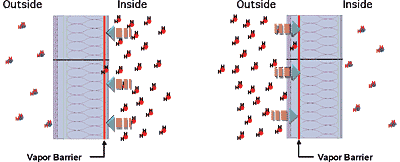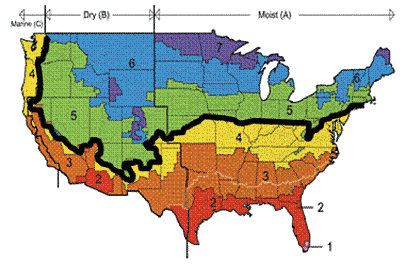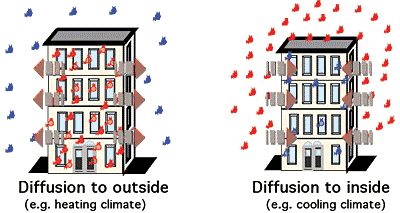Moisture Management in Wall Assemblies: Air, Water, and Vapor Barriers
Vapor Barriers
Vapor diffusion is another source of moisture for the building enclosure, and a vapor barrier (or vapor retarder) is sometimes used to control diffusion and potential condensation. However, the amount of water vapor transported through vapor diffusion is significantly lower than the amount transported by air currents. It is estimated that less than 2% of all water vapor movement through the building enclosure is due to diffusion, while over 98% is due to air transported moisture. Consequently, in order to avoid conditions which could lead to interstitial condensation it is critical to firstly protect against air leakage (using air barriers), and protect against vapor diffusion when appropriate. The installation requirements for air barriers and vapor barriers are quite different, and using a single membrane to perform both functions (e.g. air and vapor barrier) could lead to condensation problems if not properly understood. For example, while the location of air barriers within the building envelope is not important from the standpoint of controlling air leakage, and the air barrier can be located anywhere in the wall assembly, the vapor barrier location is critical for condensation control, and it is climate specific.
Typical vapor barrier location in the wall assembly |
|
Heating Climates Vapor barrier inside |
Cooling Climates Vapor barrier outside |
 |
|
The vapor barrier must be located on the side of the building envelope with higher vapor pressure in order to prevent diffusion into the envelope, known as diffusion wetting, and not interfere with diffusion of incidental moisture out of the envelope, or diffusion drying. As a general rule, for walls with insulation inside the stud cavity, the vapor retarder should be located toward the inside in climates dominated by heating, and toward the outside in cooling dominated climates.
While these general rules are useful guidelines, it is still appropriate to conduct a condensation analysis for specific climates, building envelope systems, and intended building use. Many U.S. climates have both heating and cooling cycles, and simple rules may not apply. In such cases, the vapor barrier may end up on the wrong side during one of the two cycles.
The vapor barrier codes were first introduced in Canada, with predominantly heating climates, where vapor barriers were installed on the interior (warm) side of the wall. The IBC then adopted similar requirements across all U.S. climate zones, without a proper understanding of the impact of vapor barriers in different climates. As a greater understanding of different climate needs and the consequences of the impact of vapor barriers on diffusion drying was reached, the code was changed. The 2006 IBC no longer has prescriptive requirements for vapor barrier use in mixed climate zones 1, 2, 3, and 4, which cover southern and coastal zones of the U.S.
US Climate zone map
The 2006 International Building Code does not mandate vapor barrier use in climate zones 1, 2, 3, and 4 (below the black line) |
 |
Climate Issues
The reason climate is important when considering diffusion drying is because the climate determines the exterior temperature and relative humidity. This determines the exterior vapor pressure, hence the vapor pressure difference between the exterior and the interior conditioned space, therefore the diffusion direction. The climate determines how buildings dry, whether towards the inside or towards the outside, depending upon the sign of the vapor pressure difference, whether positive or negative.
Diffusion direction: from higher to lower water vapor concentration (or higher to lower vapor pressure) and it is climate specific
|
 |
Material Choices
The choice of materials is critical for providing a diffusion open pathway in order to promote diffusion drying. As a general rule, condensation control requires that the building envelope materials increase in permeance in the direction of vapor diffusion. This means that in predominantly heating climates, where diffusion is typically from the inside to the outside, the wall assembly must have vapor permeable materials towards the outside. In cooling climates, where diffusion is typically from the outside to the inside, the wall assembly must have vapor permeable materials towards the inside. In mixed climates, proper moisture management requires diffusion open pathways in both directions, to the inside during summer and to the outside during winter.
|










